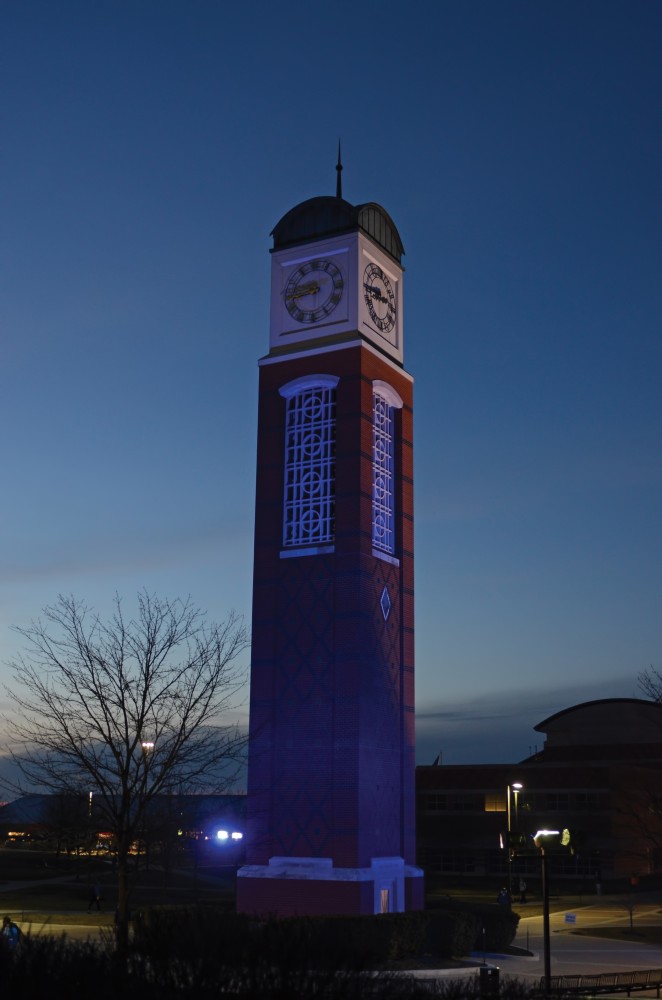Carillon clock tower turns cerulean in honor of autism awareness

Apr 6, 2014
In the United States, one in every 68 children has an autism spectrum disorder.
That statistic used to be one in 88 just two years ago, according to new information released by the Centers for Disease Control on March 27.
The new report was released just before the month of April, which is National Autism Awareness Month and April 2, which is World Autism Awareness day. In honor of this day and the entire month of April, Grand Valley State University’s organization Students Toward Autism Advocacy and Respect lit the clock tower blue, the color of autism awareness, the evenings of April 1 and 2.
“Our goal is to first spread awareness of autism on campus,” STAAR Secretary Stephanie Spruit said. “A lot of people have heard the word autism before but they don’t know what it is. We want to spark the curiosity of other people by lighting the clock tower blue and hopefully carry out the message of what autism is.”
In order to help people understand autism, STAAR set up a table in Kirkhof for passersby to be able to learn more about the disorder. Autism is a neural development disorder that often impairs social interaction, verbal, non-verbal communication and behavior.
“Autism is a mental disorder which is about differing perceptions,” said Cullen McCurdy, a GVSU student diagnosed with autism. “Autistics see and process the world differently.”
STAAR also had an awareness tree decorated with puzzle pieces within Kirkhof Center where students and faculty could write down how autism has positively affected them and hang it on the tree.
“I think the tree is awesome as a form of positive awareness for autism,” STAAR President Ken Pierson said. “There’s a lot of negative misconceptions surrounding autism and I think at times that is dehumanizing. I think by viewing it so negatively it really detracts from the personhood of individuals that are on the autism spectrum.”
STAAR is a brand new organization to campus, which started this fall after Pierson conducted an independent study on the social support offered to autistic students on college campuses. Noticing there was a lack of autism-specified support, he and his peers banded together to create an organization that would help autistic students on campus and in the community.
“First and foremost our goal is to provide peer to peer support to college students on the autism spectrum,” Pierson said. “Individuals on the autism spectrum require a specialized type of support and that’s primarily social support.”
STAAR meets every other Wednesday in the South D apartment building. At their meetings they host social events like Jeopardy nights and often volunteer in the community.
“The goal of STAAR is to create those inclusive social opportunities for individuals that otherwise perhaps would not be exposed to those situations,” Spruit said.
“We want to get our students involved in different organizations on campus and broaden their social horizons. We want to create natural support by hanging out and doing fun things together in a climate that isn’t too contrived but that is also safe and easy to make friends in.”
STAAR also strives to help others understand the disorder more and eliminate negativity that sometimes surrounds autism.
“We want to try and spread a positive perception of autism,” Pierson said. “I think often times there’s a lot of fear and mysticism surrounding autism.”
McCurdy believes that understanding is the next step after awareness.
“A lot of people know autism exists but we still have misconceptions everywhere,” McCurdy said. “It is time we started getting them cleared up so that we can have actual conversations about this instead of saying ‘Hey, by the way, this exists.’ Understanding is really just an extension of awareness. Building understanding is, for the most part, as simple as getting people to talk to us.”
STAAR hopes to gain membership as the organization becomes more recognized. The blue-lit clock tower is expected to get them that recognition.
“It’s good that Grand Valley is supporting of neurodiversity and diversity in general,” Pierson said. “It’s a way of showing support for those that process information differently than most.”























